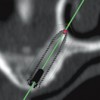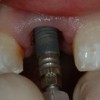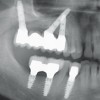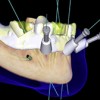The purpose of this presentation is to discuss the principles of metal-ceramic crown preparations in the anterior region. The three types of finish lines are discussed and demonstrated and the rationale for their use including the chamfer, the shoulder and the shoulder-bevel. The types of margin designs including metal collar, metal thinned to a fine line and porcelain margins are clearly demonstrated. Finally the clinical steps employed for tooth preparation are demonstrated in detail.
Transcript
- 1. Tooth preparation guidelines for anterior metal ceramic crowns Charles J. Goodacre, DDS, MSD Professor of Restorative Dentistry Loma Linda University School of Dentistry This program of instruction is protected by copyright ©. No portion of this program of instruction may be reproduced, recorded or transferred by any means electronic, digital, photographic, mechanical etc., or by any information storage or retrieval system, without prior permission.
- 2. The Morphology of metal ceramic single crowns & fixed partial dentures should closely simulate atural tooth morphology This is only possible with adequate tooth preparation
- 3. Key Tooth Preparation Form Decisions • Finish line form -3 types have been used: – Chamfer – Shoulder – Shoulder-bevel • Margin design
- 4. Shoulder With A Beveled Finish Line • Some people think it makes for a better fitting crown • It is certainly acceptable to use such a finish line but it does not make the crown fit better and it does not work with a porcelain margin
- 5. Shoulder Finish Lines • Shoulder finish lines provide greater cervical space for an esthetic thickness of porcelain without overcontouring the crown and can be used with porcelain margins Shoulder with sharp axiogingival line angle Shoulder with rounded axiogingival line angle Chamfer
- 6. Why Use A Shoulder Finish Line? • Need for optimal porcelain thickness near the margin for esthetics and particularly when optimal reduction is not possible
- 7. Finish Line Form Can Affect The Potential For Gingival Trauma
- 8. Why Use A Shoulder With A Rounded Axiogingival Line Angle? • Easier to prepare than a sharp angle • Required for any crown that will be milled
- 9. Why Use A Shoulder With A Rounded Axiogingival Line Angle? • Easier to prepare than sharp angle • Required for any crown that will be milled • Produces less tooth weakening than sharp axiogingival line angles for small teeth or RCT, teeth that will be subjected to greater force since they are FPD abutments, and teeth with substantial secondary dentin where there is very little pulp space remaining (older patients)
- 10. Key Tooth Preparation Form Decisions • Finish line form (3 types have been used: chamfer; shoulder; and shoulder-bevel) • Margin design
- 11. Margin Design • Metal collar – ease of fabrication for non-esthetic situations
- 12. Margin Design • Metal collar – ease of fabrication • Metal thinned to a fine line that is barely visible – improved esthetics compared to metal collar and greater strength than a ceramic margins
- 13. Margin Design • Metal collar – ease of fabrication for non- esthetic situations • Metal thinned to a fine line that is barely visible – improved esthetics compared to metal collar but more opacity than porcelain margin • Porcelain (collarless metal ceramic crown) – most esthetic result but requires very skillful technician
- 14. Why Use A Shoulder Finish Line And Ceramic Margin? • Enhanced cervical esthetics • When there is gingival inflammation due to overcontoured crowns and you want to make slightly undercontoured crowns to improve the gingival response
- 15. At Cementation 4 Weeks Postcementation
- 16. 2013 – 4 year PO 2009 – Pretreatment
- 17. Pretreatment Cementation – December 2011 2 month PO February 2012 9 month PO August 2012 17 month PO May 2013
- 18. TOOTH PREPARATION STEPS FOR ANTERIOR METAL CERAMIC CROWNS & FIXED PARTIAL DENTURES
- 19. AXIAL REDUCTION Facial Proximal Lingual
- 20. Axial Reduction • The axial surfaces need to be sufficiently reduced to provide an esthetic thickness of porcelain on all visible surfaces • The lingual surface and some proximal surfaces may not require an ideal thickness of porcelain because they are not visible
- 21. It is common to remove crowns and find inadequate finish line depth
- 22. The proximal surfaces of anterior teeth need adequate reduction to allow reproduction of normal translucency in the ceramic crowns
- 23. Facial Surface Reduction
- 24. Facial Surface Reduction • Using a coarse grit diamond instrument, prepare facial depth grooves that follow the incisocervical curvature of the facial surface. • The depth of the grooves varies with patient age. It is recommended that the grooves be 0.8 – 1.0 mm deep in young patients and 1.0 – 1.2 mm deep in older patients. Depths of 0.8 – 1.0 may not be possible on small teeth, teeth with large pulps, and teeth where the finish line will be located apical to the cervical line. Finish line depths of 1.2 – 1.5 mm produce excessive reduction of tooth structure on most teeth.
- 25. • When teeth are prepared with finish lines that actually approach or reach 1.5 mm, the teeth are usually structurally compromised
- 26. 0.8 mm 1.0 mm
- 27. • The combined thickness of enamel and dentin on young teeth does not support facial reductions that approach 1.5 millimeters without encroaching on the pulp
- 28. Facial Tooth Thickness (mm) (pulp to external surface) • 10-19 1.8 2.0-2.1 2.7 • 20-40 1.9-2.4 2.1-2.3 2.9-3.1 • 40-60 2.0-2.8 2.1-2.3 2.8-2.9 Oshshi, 1968, from Rosenstiel, Contemporary Fixed Prosthodontics Age Central Lateral Canine
- 29. • Available tooth structure thickness at the cervical line is limited and particularly on the proximal surfaces
- 30. Maxillary Tooth Thickness (At the cervical line) (Patient age range: 28-37) • Central Incisor 2.3 2.2 • Lateral Incisor 2.1 1.8 • Canine 2.8 2.1 Stambaugh, J Prosthet Dent 1977;37:537-546 Tooth Facial Mesial
- 31. REDUCTIONS THAT MEET OR EXCEED 1 mm CANNOT BE PRODUCED ON YOUNG TEETH WHERE THE PULPS ARE RELATIVELY LARGE
- 32. Gingival recession and the position of abutments relative to each other can limit the depth and location of facial finish lines
- 33. Data Regarding Finish Line Depth
- 34. Mean Facial Shoulder Depth • 24 extracted teeth prepared by 3 different faculty members with at least 6 years of experience • No shoulders were within the common recommendations of 1.2 – 1.5 mm depth • Mean depth of 0.75 mm • Range from 0.47 to 1.1 mm Seymour, 1996
- 35. MC Facial Shoulder Depths • Incisors – 0.8 mm mean depth • Canines – 0.9 mm mean depth Poon, Quintessence Int 2001;32:603-610
- 36. MC Finish Line Depths • 0.86 mm mean facial shoulder • 0.7 mm mean chamfer depths on mesial, distal, and lingual surfaces • 0.45 mm mean facial shoulder on mandibular incisors Al-Omari, 2004
- 37. FL Dimension Before & After Preparation: 1 mm Coronal to Finish Line • 250 teeth from 42 patients • Maxillary anterior – 0.85 mm mean • Mandibular anterior – 0.71 mm Ehrlich, J Prosthet Dent 1981;46:153-156
- 38. Reduction depths in excess of 1.0 mm can be only achieved on mature teeth where considerable secondary dentin formation has occurred and the pulp dimensions have been reduced
- 39. • The use of depth grooves assures uniform reduction that enhances the esthetic result by providing uniform space for the ceramic material that overlays the metal casting
- 40. • Select a diamond instrument with a tip diameter of about 0.8 to 1.0 mm, depending on tooth and pulp size. Prepare facial grooves until their depth matches the instrument diameter or exceeds that dimension on mature teeth
- 41. 1 mm diameter instrument
- 42. The reduced facial surface should follow the curvature of the facial surface on adjacent unprepared teeth
- 43. AXIAL REDUCTION Proximal Surfaces
- 44. • Following the depth of the grooves, uniformly reduce the facial surface. • Also, uniformly reduce both proximal surfaces while establishing a finish line of the desired depth. • A total occlusal convergence angle of 10 – 20 degrees is established between the mesial and distal surfaces.
- 45. AXIAL REDUCTION Lingual Surface
- 46. • When restoring the cervical aspect of the lingual surface with metal, reduce the lingual surface (cervical to the cingulum) and form a 0.3 – 0.5 mm deep chamfer finish line Lingual reduction cervical to the cingulum
- 47. A chamfer finish line was used on the lingual surface where a metal margin was used
- 48. Aligning Tapered Round End Diamond Instrument With Facial Surface So Lingual Can Be Reduced A Lingual Chamfer Finish Line Is Formed That Is 0.3 – 0.5 mm deep
- 49. • When restoring the cervical aspect of the lingual surface with porcelain, reduce the lingual surface (cervical to the cingulum) and form a 0.5-0.8 mm deep shoulder finish line with a rounded axiogingival line angle
- 50. • The total occlusal convergence between the facial and lingual surfaces and also between the mesial and distal surfaces should be between 10 and 20°.
- 51. Greater faciolingual convergence is sometimes needed so crowns & FPDs can have compatible morphology with adjacent unprepared teeth that have considerable occlusal convergence to their facial & lingual surfaces In these situations, the loss of resistance form should be compensated for by increasing the occlusocervical dimension, adding proximal grooves/boxes or both.
- 52. The mesial surface has been modified to include a proximal groove that will increase resistance form
- 53. • Creating a somewhat abrupt transition between the deeper facial reduction and the proximal surfaces enhances resistance form by functioning like one-half of a groove
- 54. Proximal transition from shoulder to chamfer
- 55. INCISAL REDUCTION
- 56. • Depths grooves, 2.0 mm deep, are prepared into the incisal aspect of anterior teeth and they are then used as guides to uniformly reduce the incisal edge, following its mesiodistal form INCISAL REDUCTION
- 57. INCISAL REDUCTION
- 58. • The available incisal thickness of enamel and dentin safely supports reductions of 2.0 mm, even on young teeth INCISAL REDUCTION
- 59. Incisal Tooth Thickness (pulp to incisal edge) • 10-19 4.7-4.8 3.9-4.3 4.4 • 20-40 4.8-5.5 4.8-5.2 4.6-4.8 • 40-60 6.2-6.3 4.8-6.0 4.8-5.4 Oshshi, 1969, from Rosenstiel, Contemporary Fixed Prosthodontics Age CI LI Ca
- 60. LINGUAL REDUCTION FOR OCCLUSAL CLEARANCE
- 61. • The lingual surface of anterior teeth should be reduced at least 1.0 mm for occlusal clearance with the opposing teeth when the lingual surface will be veneered with porcelain. LINGUAL REDUCTION FOR OCCLUSAL CLEARANCE
- 62. LINGUAL REDUCTION FOR OCCLUSAL CLEARANCE
- 63. • When the lingual surface of anterior teeth will be restored with metal, reductions can be less than 1.0 mm but should still be at least 0.5 mm LINGUAL REDUCTION FOR OCCLUSAL CLEARANCE
- 64. LINGUAL REDUCTION FOR OCCLUSAL CLEARANCE
- 65. ROUNDING LINE ANGLES
- 66. • Line angles should be rounded to facilitate pouring impressions without trapping air bubbles and investing wax patterns without air inclusions • Additionally, should nodules occur in the casting, they are easier to remove when the line angles have been rounded • With CAD/CAM milled crowns, the milling tools cannot get into sharp acute angles where surfaces meet ROUNDING LINE ANGLES
- 67. ROUNDING LINE ANGLES
- 68. Tooth Preparation Review • Facial reduction of 0.8 – 1.0 mm whenever possible. Depths may have to be less than 1.0 mm in younger patients. Depths of 1.2 – 1.5 mm are not usually possible cervically. • A proximal and lingual chamfer of 0.3 – 0.5 mm for metal and 0.5 – 0.8 mm for porcelain • Uniform axial reduction that produces 10 to 20 degrees of total occlusal convergence • Incisal reduction of 2.0 mm for anterior teeth • 1.0 mm of occlusal clearance for anterior teeth and 2.0 mm for posterior teeth when those surfaces will be veneered with porcelain. Less reduction can be adequate when using metal to restore occlusal contact • Rounded line angles
- 69. Thank You For Your Kind Attention Charles J. Goodacre, DDS, MSD Professor of Restorative Dentistry Loma Linda University School of Dentistry
- 70. v Visit ffofr.org for hundreds of additional lectures on Complete Dentures, Implant Dentistry, Removable Partial Dentures, Esthetic Dentistry and Maxillofacial Prosthetics. v The lectures are free. v Our objective is to create the best and most comprehensive online programs of instruction in Prosthodontics


 Prosthodontic Procedures and Complications
Prosthodontic Procedures and Complications
 Single Tooth Defects in Posterior Quadrants
Single Tooth Defects in Posterior Quadrants
 Restoration of Posterior Quadrants and Treatment Planning
Restoration of Posterior Quadrants and Treatment Planning
 Computer Guided Treatment Planning and Surgery
Computer Guided Treatment Planning and Surgery
